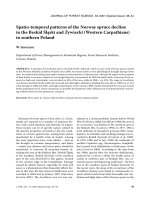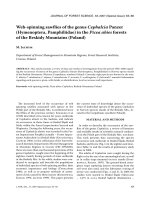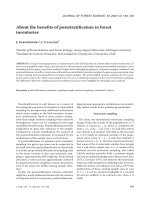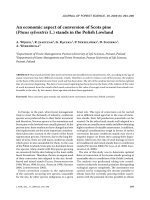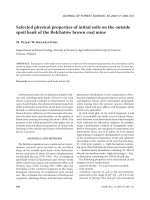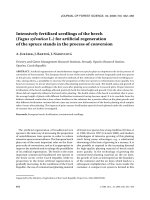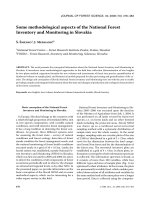Báo cáo lâm nghiệp: "About the benefits of poststratification in forest inventories" potx
Bạn đang xem bản rút gọn của tài liệu. Xem và tải ngay bản đầy đủ của tài liệu tại đây (581.1 KB, 10 trang )
J. FOR. SCI., 53, 2007 (4): 139–148 139
JOURNAL OF FOREST SCIENCE, 53, 2007 (4): 139–148
Poststratification is well known as a means of
increasing the precision of estimates in unstratified
sampling by incorporating additional information
about strata weights in the final estimator. In gen-
eral, stratification leads to more precise estima-
tions than simple random sampling when relatively
homogenous strata can be configured with large
variability between strata. Poststratification involves
assignment of units after selection of the sample.
Compared to a priori stratification, the variance of
the poststratification estimator is increased by the
randomness of the sample size in each stratum.
If poststratification is combined with systematic
sampling, the gain in precision can be suspected to
be small when the spatial distribution of strata leads
to a nearly proportional allocation of sampling units
to the strata, because in that case systematic sam-
pling is approximately self-weighting. Proportional
allocation is often at least approximately achieved
by spatial systematic sampling in forest inventories,
even if the strata are hidden during sample selec-
tion.
Finally, the poststratification variance estimator
might be a nearly unbiased estimator for the variance
of estimates based on systematic poststratified sam-
pling because appropriate stratification can remark-
ably reduce trends in the underlying spatial data.
Systematic sampling
e usual one-dimensional systematic sampling
design divides the N units of the population in k ≥ 2
clusters or classes S
1
, , S
k
, where S
i
comprises the
units i, i+k, i+2k,…, i+jk (i+jk ≤ N), and then selects
one of these S
i
at random. Selecting so the first unit
as 1 of k yields an unbiased estimate of the popu-
lation mean when N = n × k, but that estimate is
biased when N ≠ n × k. e bias arises from the fact
that some of the k systematic samples have sample
size n and others sample size n+1. A variant of the
method, circular systematic sampling, also called
Lahiri’s method, provides both a constant sample
size and an unbiased sample mean (B, R
1975; C 1977), but destroys the systematic
structure of the sample by combining units from two
different clusters. According to C (1977) the
implications of those varying sample sizes in case
N ≠ n × k can be assumed negligible if n exceeds
50 and are unlikely to be relevant even when n is
small.
About the benefits of poststratification in forest
inventories
J. S
1
, J. C
2
1
Faculty of Forest Sciences and Forest Ecology, Georg-August University, Göttingen, Germany
2
Facultad de Ciencias Forestales, Universidad de Concepción, Concepción, Chile
ABSTRACT: A large virtual population is created based on the GIS data base of a forest district and inventory data. It
serves as a population where large scale inventories with systematic and simple random poststratified estimators can be
simulated and the gains in precision studied. Despite their selfweighting property, systematic samples combined with
poststratification can still be clearly more efficient than unstratified systematic samples, the gain in precision being close
to that resulting from poststratified over simple random samples. e poststratified variance estimator for the condi-
tional variance given the within strata sample sizes served as a satisfying estimator in the case of systematic sampling.
e differences between conditional and unconditional variance were negligible for all sample sizes analyzed.
Keywords: poststratification; systematic sampling; simple random sampling; conditional variance
140 J. FOR. SCI., 53, 2007 (4): 139–148
In general, n can not be arbitrarily fixed in advance.
If N = n × k + c (c ≥ 0) and c < k, then there are c
samples of size n+1 and k-c samples of size n. When
2k > c > k, c– k systematic samples have n+2 units
and the remaining have n+1 units. In more extreme
cases, the sample size finally obtained can over- or
underride the desired one remarkably. For example,
with N = 102 and n = 30 desired N / n = 102 / 30 = 3.4
is obtained and one can choose among k = 3 or k = 4
systematic samples. In the first case c = 12 and
3 samples of size n = 34 are obtained, in the second
case (c = 2) two systematic samples of size 25 and
two of size 26 exist.
In two dimensions, a natural extension of one-
dimensional systematic sampling is sampling on a
regular grid. Most frequently, square grids are used
in practice, although triangular grids may often be
superior (C 1977; M 1960). Here,
variability of sample size is usually even greater
than in the one-dimensional case. e different
systematic samples may vary by much more than
one unit in size. For example in a squared popula-
tion with N = 102 × 102 = 10,404 units, drawing
each tenth unit in both directions results in 100 dif-
ferent systematic samples of varying size, that is,
64 samples of size 100, 32 of size 110, and 4 of size
121. In sampling a nonrectangular area, variability
of the sample size will further be increased depend-
ing on the irregularity of the particular shape of the
area. With poststratification there is an additional
variability of sample sizes within strata (V
1993).
A well-known drawback of systematic sampling
is the absence of an unbiased variance estimator.
us, practitioners make use of the simple random
sampling variance estimator or one of the alterna-
tives offered in the literature (e.g. W 1985). e
simple random sampling variance estimator often
overestimates the true variance because it does not
consider the self-weighting property of systematic
sampling in case of hidden strata or spatial trends.
en systematic sampling has similar properties
as stratified sampling with proportional allocation
of samples and poststratified variance estimators,
might be less biased.
With simple random sampling and appropriately
large population and sample sizes, the sample means
can be expected to be approximately normally dis-
tributed. is does not hold for systematic sampling,
where the number of possible samples decreases with
increasing sample size (M, M 1944).
Whereas with simple random sampling the variance
of the sample mean monotonically decreases with
increasing sample size, this is not true for systematic
sampling. Instead, there is a decreasing trend with
erratic fluctuation (M 1946).
Poststratification
Poststratification means assigning sampling units
to strata after observation of the sample, i.e. stratifi-
cation is imposed at the analysis stage rather than at
the design stage (S et al. 2003). erefore,
sample sizes within strata can not be fixed in ad-
vance but must be assumed random depending on
the samples actually selected. is is an additional
source of variation.
Poststratification is usually applied when addi-
tional information about strata sizes is available. In
the ideal case this additional information comprises
the true strata weights, which might be known from
previous work or other external data sources (C-
1977; S 1991; V 1993). As with
a priori stratification, poststratification can be based
on one or more classification variables defining the
strata.
With large sample sizes and simple random sam-
pling, and even more with systematic sampling,
poststratification can be expected to correspond
approximately to stratified sampling with propor-
tional allocation. Usually, it is discussed as a method
supposed to increase precision (C 1977;
V 1993; S et al. 2003), because it
reduces selection biases by reweighting after sam-
ple selection (S 1991; L 1993; R et al.
2002). Since systematic sampling might be expected
to come closer to proportional allocation than sim-
ple random sampling, one might conjecture that the
relative increase in precision by poststratification
will be larger with simple random than with system-
atic sampling.
G and V (1993) affirmed that the condi-
tional variance, where the condition is a given sample
allocation, is the proper instrument for comparing
the poststratification mean with the regular simple
random or systematic sampling mean as estima-
tors of the true population mean. ey observed
that the poststratified mean is often superior to the
regular mean when the conditional variance or the
conditional mean square error is used for compar-
ing both estimators (G, V 1988). H and
S (1979) affirmed that, in theory, neither the
post stratification estimator nor the sample mean
is uniformly best in all situations but empirical in-
vestigations indicate that post stratification offers
protection against unfavourable sample configura-
tions and should be viewed as a robust technique. As
each stratum mean is weighted by the relative size
J. FOR. SCI., 53, 2007 (4): 139–148 141
of that stratum in the population, the post stratified
estimator automatically corrects for any badly bal-
anced sample.
Variances and variance estimation
e unconditional variance of the poststratified
mean
L
–
y
st.post
=
Σ
W
h
–
y
h
h=1
with
–
y
h
the sample mean in stratum h and samples
of size n randomly selected in a population with L
strata is approximately
1
n
L
1
L
σ
2
–
y
st.post.uncond
≈
(
1 –
)
Σ
W
h
S
2
h
+
Σ
(1– W
h
)S
2
h
(1)
n
N
h=1
n
2
h=1
where W
h
and S
2
h
are, respectively, the relative size
and the variance of stratum h (C, 1977,
5A.42). e first term in equation (1) is the vari-
ance of the estimator
–
y
st
of the population mean in
(pre)stratified random sampling with proportional
allocation
1
n
L
σ
2
–
y
st.prop
=
(
1 –
)
Σ
W
h
S
2
h
(2)
n
N
h=1
and the second represents the increase in vari-
ance that arises from the randomness of the n
h
(C- 1977, p. 134 f.). It is evident that this
term approximates zero when n→∞. Furthermore,
if the S
2
h
do not differ greatly, the increase is about
(L – 1)/n times the variance for proportional alloca-
tion, ignoring the finite population correction. With
n >> L the increase due to the second term in equa-
tion (1) is small compared with equation (2).
Because of the randomness of the within strata
sample sizes, the variance formulas for prestratified
samples may be regarded as inappropriate (W-
1962). However, although the variance of a
poststratified estimator can be computed uncondi-
tionally (i.e., across all possible realizations of within
strata sample sizes), inferences made conditionally
on the achieved sample configuration are desirable
(V 1993). e conditional variance of the
poststratified mean, that is the variance given the
within strata sample sizes n
1
, , n
L
is
L
σ
2
–
y
st.post.cond
= Var
post
(
Σ
W
h
–
y
h
|n
1
, , n
L
)
=
h=1
L
W
2
h
n
h
=
Σ
––––– S
2
h
(
1 – –––
)
(3)
h=1
n
h
N
h
e respective estimators of (1), (2) and (3) are obtain-
ed by simply substituting the estimator s
2
h
for S
2
h
, e.g.
L
W
2
h
n
h
s
2
–
y
st.post.cond
=
Σ
–––– s
2
h
(
1– –––
)
h=1
n
h
N
h
Instead of (1), T (1992) presented an
alternative approximation of the variance of the
poststratified mean, namely
1
n
L
1 N –n
L
–
(
1 – ––
)
Σ
W
h
S
2
h
+ ––
(
–––––
)
Σ
(1 –W
h
)S
2
h
n
N
h=1
n
2
N – 1
h=1
and he uses s
2
–
y
st.post.cond
as the according variance es-
timator, which evidently estimates (only) the condi-
tional variance given the sample allocation n
1
, , n
L
,
what is but completely satisfactory because one is
usually interested in the precision of an estimate
based on the sample allocation actually obtained
(R 1988).
With k systematic samples the i
th
of which yields a
simple mean
–
y (i) and a poststratified mean
–
y
st.post
(i),
the true variances of those estimators are by defini-
tion
1
k
1
k
σ
2
–
y
sys
=
Σ
(
–
y (i) –
Σ
–
y (i)
)
2
(4)
k
i=1
k
i=1
1
k
1
k
σ
2
–
y
st.post.sys
=
Σ
(
–
y
st.post
(i) –
Σ
–
y
st.post
(i)
)
2
(5)
k
i=1
k
i=1
Finally, the variance of the sample mean
–
y in simple
random sampling is denoted by
1 n 1
N
σ
2
–
y
=
(
1 –
)
Σ
(y
i
–
–
y )
2
(6)
n
N N – 1
i=1
and, based on k simple random samples, we use
1
k
1
k
~
σ
2
–
y
=
Σ(
–
y (i) –
Σ
–
y (i)
)
2
(7)
k
i=1
k
i=1
1
k
1
k
~
σ
2
–
y
st.post
=
Σ(
–
y
st.post
(i) –
Σ
–
y
st.post
(i)
)
2
(8)
k
i=1
k
i=1
for the simulated variances of simple and poststrati-
fied means. e ~ is used to symbolize the variances
approximated by simulation; variances (4) and (5) are
true variances because all k systematic samples are
considered. In the simulation study equations (6) and
(7) should give almost equal results.
Data base and virtual forest landscape
In order to carry out a large scale simulation study,
it was intended to create an artificial population as
close as possible to a real forest landscape. ere-
fore, volume data and actual forest coverage from a
geographical information system of the Solling area
(Lower Saxony, Germany) were used as the data
base. Volume data stem from a forest district inven-
142 J. FOR. SCI., 53, 2007 (4): 139–148
tory based on concentric circular plots where tree
species and diameter in breast height of all sample
trees are available as well as some heights required
for calculating volumes (B et al. 1998). In
total, data from 5,680 sample plots were incorpo-
rated in the creation of a virtual population.
e virtual population (Fig. 1) is represented by a
mosaic of 212,386 squares (40m by 40m side length)
each of which was assigned to one of 7 strata (Ta-
ble 1) according to the stratum of the forest stand
covering the centre of the square. Four strata were
dominated by spruce (Picea abies [L.] Karst.) and
three strata by beech (Fagus sylvatica L.).
Also, each inventory sample plot was assigned
to one of the strata and a three-parameter Weibull
function fitted to the volume per ha distribution of
all sample plots of a stratum (Table 2). e Weibull
parameters were estimated by the Maximum Likeli-
hood method, with initial parameter values α = 0.95
× V
min
, β = V
0.63
– α, and γ = β/S
V
, where V
min
is the
minimum volume, V
0.63
represents the 63
th
percen-
tile of volumes, and S
V
is the standard deviation of
the volume data. e resulting volume distributions
range from negative exponential to left-skewed
shapes (Fig. 1). From those volume distributions, the
volume per ha for each square unit of the population
was randomly selected depending on the stratum
of the square unit. at implies in particular that
trends, periodic variation or autocorrelation within
strata are unlikely.
Simulation
Systematic samples were now chosen on square
grids of 20 different grid widths representing sam-
pling intensities from 0.047% to 1.0%. ose widths
16
305
Fig. 1. Spatial coverage of the strata in Solling, relative volume frequencies and fitted Weibull
probability density function of each stratum.
306
Fig. 1. Spatial coverage of the strata in the Solling, relative volume frequencies and fitted Weibull probability density function
of each stratum
J. FOR. SCI., 53, 2007 (4): 139–148 143
were realized by selecting each 10
th
square in both
directions for about 1% sampling intensity and each
46
th
square for 0.047%. us the number of system-
atic samples obtained varyed between k = 100 for the
smallest and k = 2,116 for the largest grid width, sizes
sufficiently large to obtain n
h
> 1 in each stratum.
For each of these intensities, the total number of
different systematic samples were drawn, the values
of the corresponding sampling units identified, and
the simple (
–
y ) and stratified (
–
y
st.post
) means and the
variance estimators for each sample as well as the
true variances (4) and (5) calculated. Additionally,
random samples (without replacement) of sample
sizes equal to the mean sample sizes of the systematic
samples were drawn and the corresponding
–
y ,
–
y
st.post
,
the variance estimators as well as the “true” variances
(7) and (8) calculated. All means and variances were
averaged over the k systematic or random samples.
Sample sizes n vary among the k systematic sam-
ples and are constant among the k random samples.
However, the within stratum sample sizes vary for
both systematic and random sampling.
Table 1. Characteristics of the 7 strata for Solling data
Age class (years) Stratum N
h
W
h
Coniferous trees dominate
< 40 1 26,241 0.124
41–80 2 30,801 0.145
81–120 3 24,554 0.116
> 120 4 39,002 0.184
Broadleaf trees dominate
< 40 5 30,690 0.145
41–80 6 36,498 0.172
> 80 7 24,600 0.116
N = 212,386
Table 2. Characteristic values of volume and estimated parameters of the three-parameter Weibull function per stratum
Stratum
Number of
data points
Volume (m
3
/ha) Parameters of the Weibull function
Minimum Maximum µ σ α β γ
1 405 0.590 569.441 93.449 97.185 0.589938 89.195977 0.913904
2 372 4.228 822.673 225.129 119.641 4.228146 241.675473 1.764021
3 387 1.259 899.537 317.430 146.725 1.258811 343.767969 2.017091
4 894 0.661 1,085.414 314.517 165.170 0.661273 346.609165 1.831620
5 937 0.417 947.915 185.710 117.432 0.417108 201.749274 1.476572
6 1,658 0.923 1,037.621 348.028 160.364 0.922846 385.693802 2.159353
7 1,027 3.102 1,181.949 491.999 170.687 3.101742 535.959991 3.005017
17
307
Fig. 2. Histogram of the poststratified sample mean
.st post
y obtained from the corresponding k
different systematic samples. Here
n is the arithmetic mean of the sample size of the k
samples in the population.
308
309
310
311
Fig. 3. Standard error of the poststratified mean for systematic and random sampling, the latter
compared with the rooted mean variance estimate of the
k replicated simple random
samples and
y
V
according to (7)
312
313
314
Fig. 2. Histogram of the poststratified sample mean
–
y
st.post
obtained from the corresponding k different systematic samples.
Here n is the arithmetic mean of the sample size of the k samples in the population
n = 100
n = 402
n = 1,755
144 J. FOR. SCI., 53, 2007 (4): 139–148
RESULTS AND DISCUSSION
In theory, in a population with mean µ and va-
riance σ
2
, with simple random sampling without
replacement and with large sample size, the distri-
bution of the sample mean can be approximated
by a normal distribution with mean µ and variance
(1 – n/N) × σ
2
/n, independently of the original dis-
tribution of the variable of interest. Here, although
the estimate of the true mean is unbiased and the
variance of the mean decreases (Tables 3 and 4) with
increasing n, its histogram approximates the normal
probability density function (pdf) better for smaller
than for the larger sample sizes (Fig. 2). is is due to
the decreasing number k of systematic samples with
increasing sample size n (k = N/n).
As expected (see chapter 2), the simulation confirmed
the more or less erratic decrease of σ
–
y
st.post.sys
(Fig. 3a)
Table 3. Characteristic values of systematic
–
y
st.post
Mean
n
Number
of systematic samples
Volume (m
3
/ha)
Minimum Maximum mean
–
y
st.post
σ
st.post.sys
100 2,116 223.631 319.384 275.394 15.300
147 1,444 239.977 314.349 275.431 12.161
195 1,089 238.964 318.364 275.487 11.333
252 841 245.358 304.173 275.479 9.523
291 729 252.316 302.744 275.428 8.828
340 625 254.066 302.227 275.417 8.143
402 529 251.219 300.115 275.457 7.665
439 484 255.799 298.070 275.441 7.419
482 441 256.247 292.334 275.382 6.593
531 400 258.862 294.995 275.477 6.395
588 361 259.578 293.504 275.407 5.889
656 324 260.168 293.516 275.448 6.081
735 289 259.209 288.234 275.459 5.607
830 256 262.688 290.079 275.450 5.103
944 225 262.346 287.911 275.435 4.796
1,084 196 263.943 288.117 275.466 4.314
1,257 169 266.995 284.735 275.462 4.049
1,475 144 265.965 284.841 275.447 3.976
1,755 121 265.872 285.972 275.433 3.670
2,124 100 267.151 284.702 275.424 3.004
17
307
Fig. 2. Histogram of the poststratified sample mean
.st post
y obtained from the corresponding k
different systematic samples. Here
n is the arithmetic mean of the sample size of the k
samples in the population.
308
309
310
311
Fig. 3. Standard error of the poststratified mean for systematic and random sampling, the latter
compared with the rooted mean variance estimate of the
k replicated simple random
samples and
y
V
according to (7)
312
313
314
Fig. 3. Standard error of the poststratified mean for systematic and random sampling, the latter compared with the rooted mean
variance estimate of the k replicated simple random samples and
~
σ
–
y
according to (7)
Random
Systematic
Sample size (n) Sample size (n)
J. FOR. SCI., 53, 2007 (4): 139–148 145
with increasing sample size. e erratic behavior is
more expressed for n > k, here beyond sample sizes
of about 460, that is with sample sizes where c > k
might occur and where the variability of the sample
size n decreases slower beyond that point (Fig. 4).
Similar erratic oscillations of
~
σ
–
y
st.post
occur with
random sampling, and the rooted mean variance
estimate of the k replicated simple random samples
and
~
σ
–
y
according to (7) exhibit no remarkable dif-
ferences (Fig. 3b), although both are larger than
~
σ
–
y
st.post
.
Fig. 5a compares the square root of the means of
the estimates s
2
y
st.post.uncond
for the conditional vari-
ance (1), the means of s
2
y
st.post.cond
as estimates for the
unconditional variance (2) and the means of the
random sample variance estimates s
2
y
with the true
variance σ
2
y
st.post.sys
within the range of the analyzed
sample sizes. Obviously, s
2
y
overestimates the true
variance by far, and the conditional and uncondi-
tional variance estimators, on an average, exhibit
no remarkable differences. us, the component of
variability associated to the variability of the sample
Table 4. Characteristic values of random
–
y
st.post
Sample size
n
Number
of random samples
Volume (m
3
/ha)
Minimum Maximum mean
–
y
st.post
-
σ
st.post
100 2,116 221.263 339.764 275.452 15.505
147 1,444 237.849 315.398 275.122 13.060
195 1,089 239.759 311.636 274.785 10.768
252 841 246.214 307.115 275.199 9.615
291 729 249.701 299.559 274.906 8.587
340 625 251.328 303.244 275.899 8.288
402 529 250.967 299.248 274.377 7.504
439 484 256.562 292.695 275.097 7.067
482 441 259.611 294.242 275.809 6.560
531 400 257.124 296.154 275.342 6.834
588 361 258.846 292.583 275.493 6.279
656 324 256.534 292.863 275.233 6.090
735 289 259.901 293.623 275.352 5.243
830 256 258.429 290.645 275.150 5.318
944 225 262.949 287.922 275.372 4.644
1,084 196 261.287 292.002 275.442 4.547
1,257 169 264.998 287.275 275.283 4.270
1,475 144 264.997 287.718 275.699 4.237
1,755 121 266.267 284.233 275.063 3.294
2,124 100 267.991 284.271 275.344 3.761
Fig. 4. Sample sizes of the systematic samples and related c/k values, standard deviations (black diamonds), and coefficients of
variation (grey diamonds)
18
Fig. 4. Sample sizes of the systematic samples and related c/k values, standard deviations (black
diamonds), and coefficients of variation (grey diamonds)
315
316
317
318
319
320
321
Fig. 5. 100+bias(%) of variance estimators for the true standard deviation of the poststratified
mean in systematic and random sampling.
322
323
324
325
326
Sample size (n)Sample size (n)
Standard deviation of n
Coeff. of variation of n (%)
5.0
4.5
4.0
3.5
3.0
2.5
2.0
1.5
1.0
0.5
0.0
18
16
14
12
10
8
6
4
2
0
22
20
18
16
14
12
10
8
6
4
2
0
c/k
0 500 1,000 1,500 2,000 2,500
0 500 1,000 1,500 2,000 2,500
146 J. FOR. SCI., 53, 2007 (4): 139–148
18
Fig. 4. Sample sizes of the systematic samples and related c/k values, standard deviations (black
diamonds), and coefficients of variation (grey diamonds)
315
316
317
318
319
320
321
Fig. 5. 100+bias(%) of variance estimators for the true standard deviation of the poststratified
mean in systematic and random sampling.
322
323
324
325
326
19
Fig. 6. Relative efficiency of poststratification in systematic and random sampling; real strata.
327
328
329
330
331
332
333
Fig. 7. Artificial strata with larger connected subareas. 334
335
336
19
Fig. 6. Relative efficiency of poststratification in systematic and random sampling; real strata.
327
328
329
330
331
332
333
Fig. 7. Artificial strata with larger connected subareas. 334
335
336
Fig. 5. 100+bias(%) of variance estimators for the true standard deviation of the poststratified mean in systematic and random
sampling
Fig. 7. Artificial strata with larger connected subareas
Fig. 6. Relative efficiency of poststratification in systematic and random sampling, real strata
size is, as it was expected, practically zero. Biases
are erratic, varying predominantly within a range
of ± 5% of the true standard error of the systematic
samples. Similar results can be observed with ran-
dom sampling (Fig. 5b) where the same variance
estimators are compared with the “true” variance
σ
y
st.post
of the poststratified mean.
Taking the true standard deviation σ
y
sys
of the un-
stratified mean of a systematic sample as a reference,
the standard deviation σ
y
st.post.sys
of the poststratified
mean under systematic sampling was about 16%
smaller on the average (Fig. 6a). A similar gain in
precision can be achieved by (pre)stratified sampling
with proportional allocation in the underlying vir-
tual forest landscape. Beyond sample sizes of about
500, that is of samples where n is larger than k, the
variance ratios are less stable with gains in precision
between 6 % and 25 %.
With random sampling (Fig. 6b), gains in precision
are only slightly larger. Probably, the little size and
spatial distribution of connected areas of the diffe-
Sample size (n)Sample size (n)
Sample size (n)
Sample size (n)
RandomSystematic
RandomSystematic
J. FOR. SCI., 53, 2007 (4): 139–148 147
rent strata leads to an allocation of the samples which
is only a little closer to proportionality for systematic
sampling than for random sampling. In that case
reweighting by poststratification must have a similar
effect for both sampling techniques.
In order to analyze the influence of the spatial
structure of strata on the efficiency of poststratifi-
cation, an artificial stratification was set up (Fig. 7).
Here, the strata comprise larger connected subareas
as for the real spatial distribution of strata (Fig. 1).
e allocation of samples under systematic samples
will be closer to proportionality in that case and
should result in a lower relative efficiency of the
poststratified mean (systematic sampling). This
conjecture could be stated by the results presented
in Fig. 8. Precision increased only by about 4%,
instead of 16% before, for systematic sampling. For
random sampling the increase of precision by post-
stratification remained at the same level as for the
real stratification.
CONCLUSION
e case study presented reveals that mean esti-
mators under systematic sampling can remarkably
be improved in precision by poststratification when
strata comprise a large number of small connected
subareas. e larger connected subareas are the
less is the gain in precision. e conditional as
well as the unconditional variance estimator for
poststratified sampling were only slightly biased
(< 5%) with varying signs for different sample sizes,
particularly in case of systematic random sampling.
ey can be expected practically identical in large
scale forest inventories; here we studied sample
sizes above 100.
For random sampling, the spatial structure of
strata had no influence on the efficiency of post-
stratification compared to simple random sample
means.
With the underlying population, stratified ran-
dom sampling with proportional allocation and
poststratified systematic sampling achieved similar
precision, but this might be different when within
strata variances vary more among strata than in this
case study.
R e fer enc e s
BELLHOUSE D.R., RAO J.N.K., 1975. Systematic sampling in
the presence of a trend. Biometrika, 62: 694–697.
BÖCKMANN T., SABOROWSKI J., DAHM S., NAGEL
J., SPELLMANN H., 1998. A new conception for forest
inventory in lower saxony. Forst und Holz, 53: 219–226.
(in German)
COCHRAN W.G., 1977. Sampling Techniques. New York,
Wiley: 428.
GHOSH D., VOGT A., 1988. Sample configuration and con-
ditional variance in poststratification. American Statisti-
cal Association Proceedings, Section on Survey Research
Methods: 289–292.
GHOSH D., VOGT A., 1993. Some theorems relating post-
stratification and sample configuration. American Statisti-
cal Association Proceedings, Section on Survey Research
Methods: 341–345.
HOLT D., SMITH T.M.F., 1979. Post stratification. Journal of
the Royal Statistical Society A, 142: 33–46.
LITTLE R.J.A., 1993. Post-stratification. A modeler’s per-
spective. Journal of American Statistical Association, 88:
1001–1012.
MADOW W.G, MADOW L.H., 1944. On the theory of
systematic sampling. Annals of Mathematical Statistics,
15: 1–24.
MADOW L.H., 1946. Systematic sampling and its relation
to other sampling designs. Journal of American Statistical
Association, 41: 204–217.
MATÉRN B., 1960. Spatial variation. Meddelanden från sta-
tens Skogsforskningsinstitut, 49: 1–144.
20
337
Fig. 8. Relative efficiency of poststratification in systematic and random sampling, artificial 338
strata. 339
340
341
342
343
344
345
346
347
348
349
350
351
352
353
354
355
356
357
358
359
360
361
362
363
364
365
366
367
368
369
370
371
372
Corresponding author: 373
374
Prof. Dr. J. Saborowski, Institut für Forstliche Biometrie und Informatik, Büsgenweg 4, D-375
37077 Göttingen, Germany 376
Tel.: +49 551 39 3450, fax: +49 551 39 3465, e-mail: 377
Fig. 8. Relative efficiency of poststratification in systematic and random sampling, artificial strata
Random
Systematic
Sample size (n)
Sample size (n)
148 J. FOR. SCI., 53, 2007 (4): 139–148
RAO J.N.K., 1988. Variance estimation in sample surveys. In:
KRISHNAIAH P.R., RAO C.E. (eds.), Handbook of Statis-
tics, Vol. 6 (Sampling). Amsterdam, Elsevier: 427–444.
RAO J.N.K., YUNG W., HIDIROGLOU M.A., 2002. Estimat-
ing equations for the analysis of survey data using poststrati-
fication information. Sankhya, 64 A: 364–378.
SMITH T.M.F., 1991. Post-stratification. e Statistician, 40:
315–323.
STEHMAN S.V., SOHL T.L., LOVELAND T.R., 2003. Statisti-
cal sampling to characterize recent United States land-cover
change. Remote Sensing of Environment, 86: 517–529.
Corresponding author:
Prof. Dr. J S, Institut für Forstliche Biometrie und Informatik, Büsgenweg 4, 37077 Göttingen,
Germany
tel.: + 49 551 393 450, fax: + 49 551 393 465, e-mail:
THOMPSON S.K., 1992. Sampling. New York, Wiley: 1–343.
VALLIANT R., 1993. Poststratification and conditional vari-
ance estimation. Journal of American Statistical Associa-
tion, 88: 89–96.
WILLIAMS W.H., 1962. e variance of an estimator with
poststratified weighting. Journal of American Statistical
Association, 57: 622–627.
WOLTER K.M., 1985. Introduction to Variance Estimation.
New York, Springer: 1–427.
Received for publication April 10, 2006
Accepted after corrections May 11, 2006
O přínosech poststratifikace v lesnické inventarizaci
ABSTRAKT: Na základě GIS databáze a údajů lesnické inventarizace pro určitý úsek lesa byl vytvořen rozsáhlý
virtuální základní soubor. Tento soubor byl využit pro simulaci velkoplošné inventarizace s odhady parametrů zís-
kanými pomocí poststratifikace systematického a jednoduchého náhodného výběru a pro studium zvýšení přesnosti
odhadu. Přes systematický výběr kombinovaný s poststratifikací se jeví stále ještě efektivnější než nestratifikovaný
systematický výběr, zvýšení přesnosti se blíží výsledkům získaným z jednoduchého náhodného výběru s poststrati-
fikací. Poststratifikovaný odhad rozptylu pro podmíněný rozptyl stanovený na základě velikosti výběrů jednotlivých
oblastí (strat) slouží jako uspokojivý odhad v případě systematické
ho výběru. Rozdíly mezi nepodmíněným a pod-
míněným rozptylem byly shledány pro všechny analyzované velikosti výběru jako zanedbatelné.
Klíčová slova: poststratifikace; systematický výběr; jednoduchý náhodný výběr; podmíněný rozptyl

